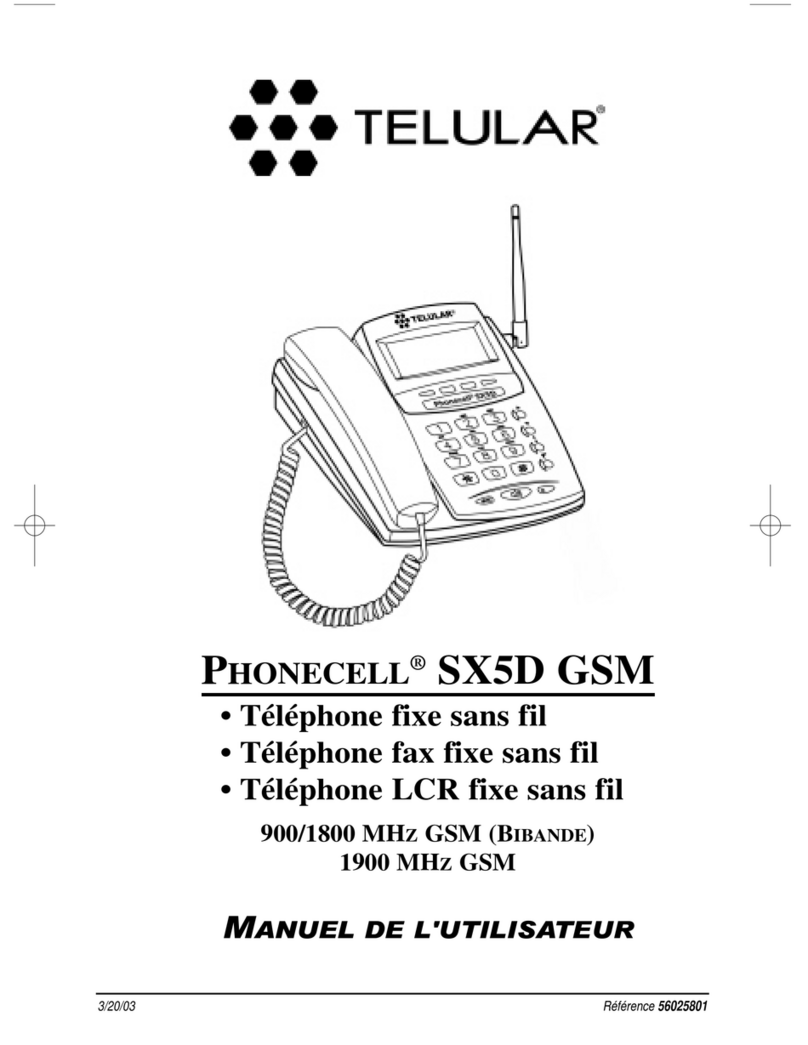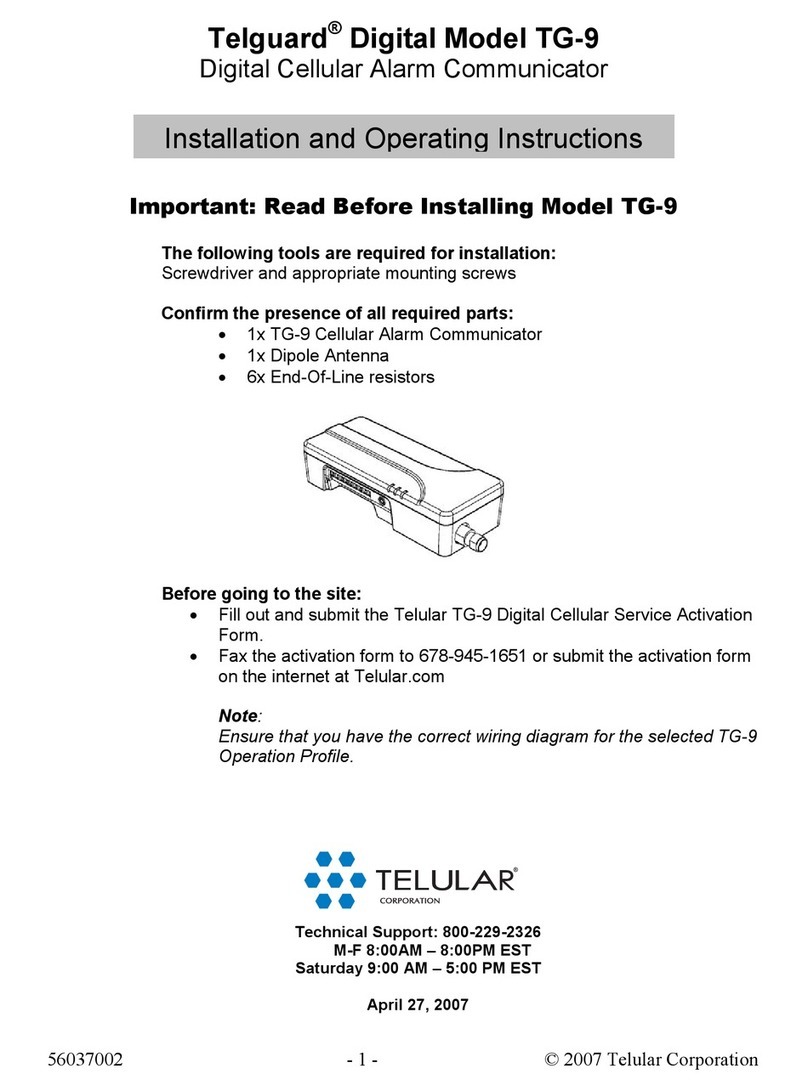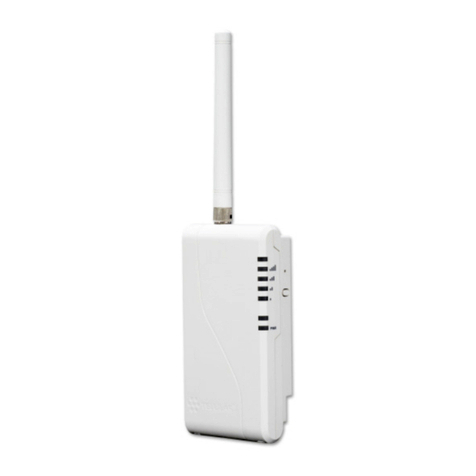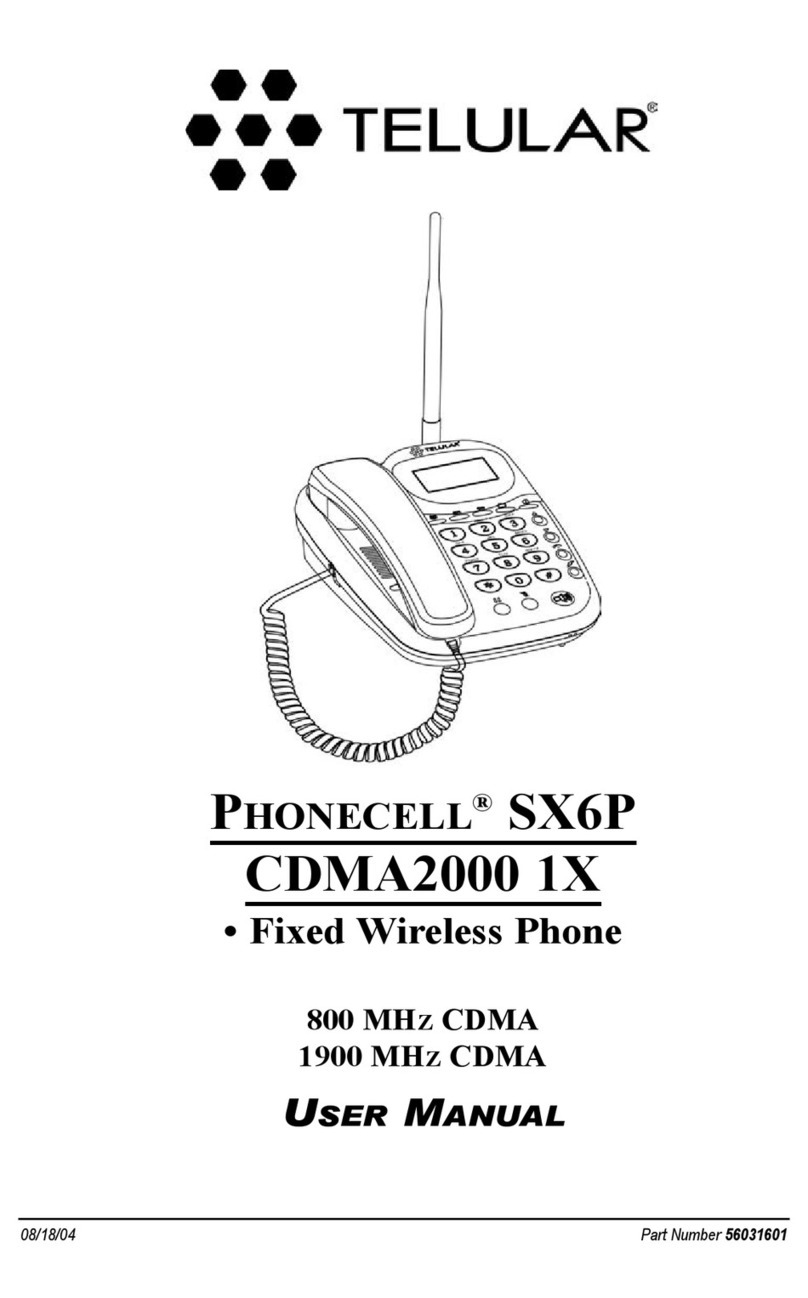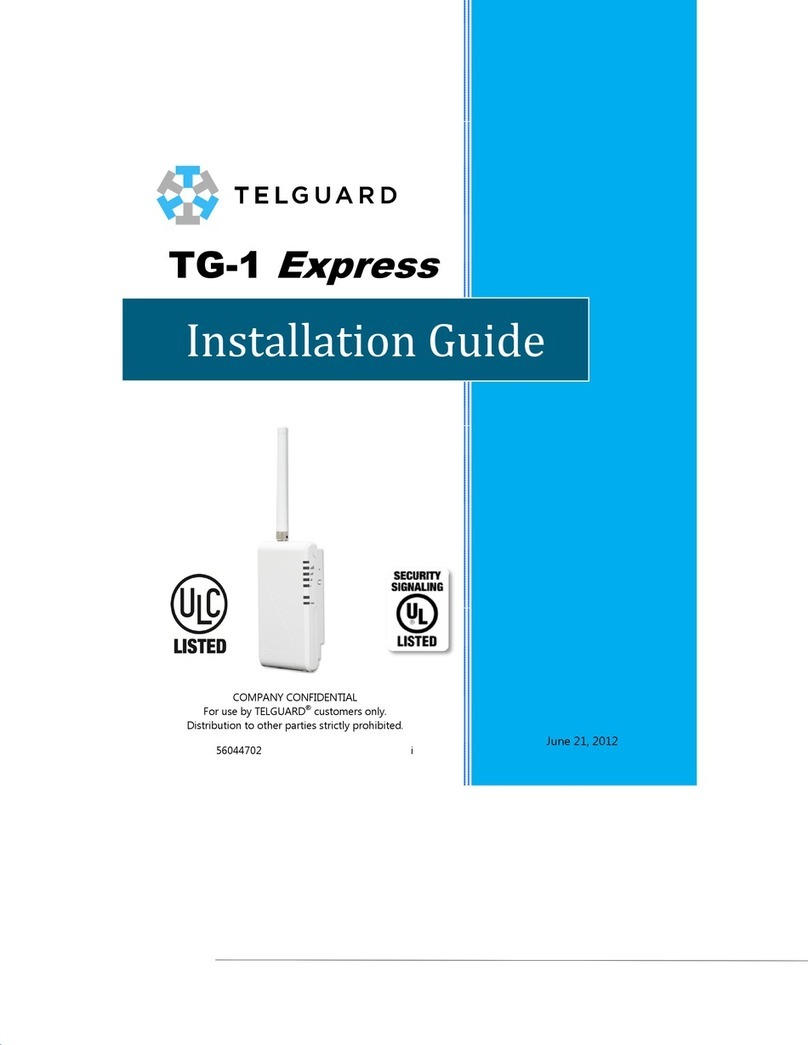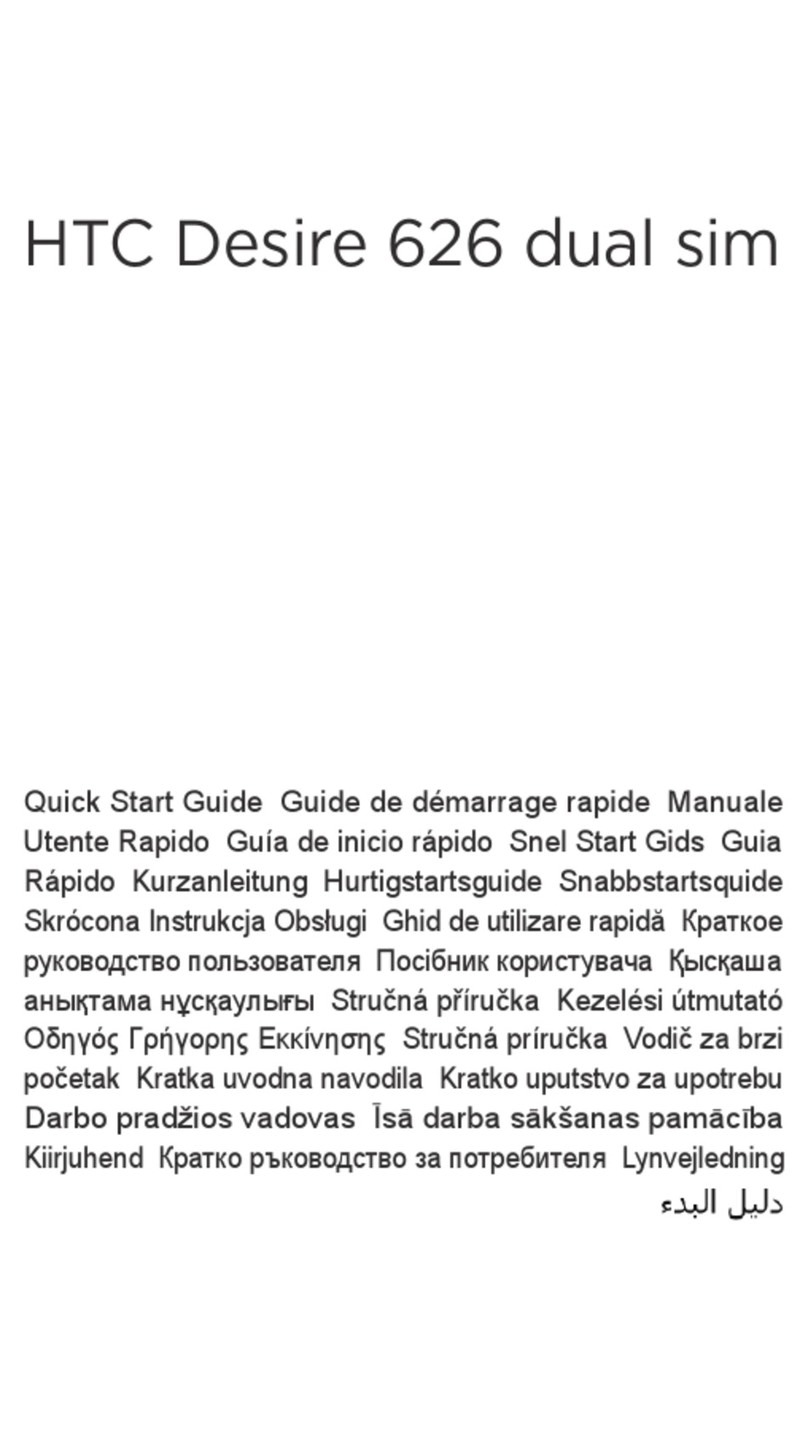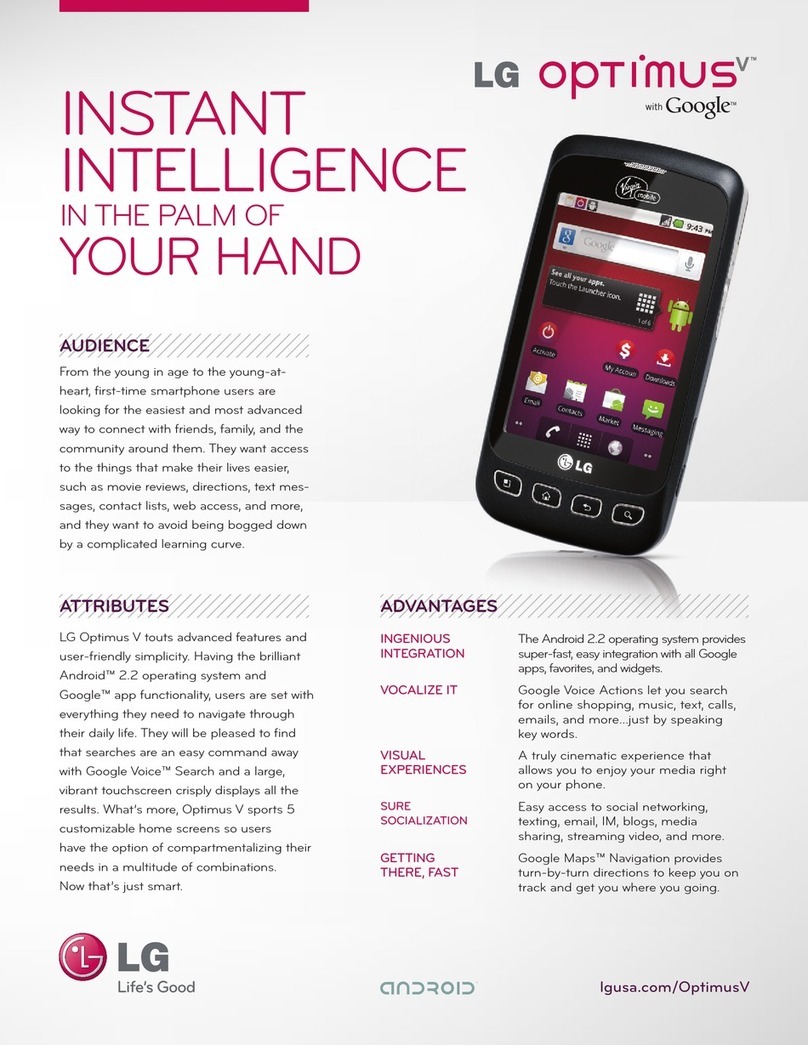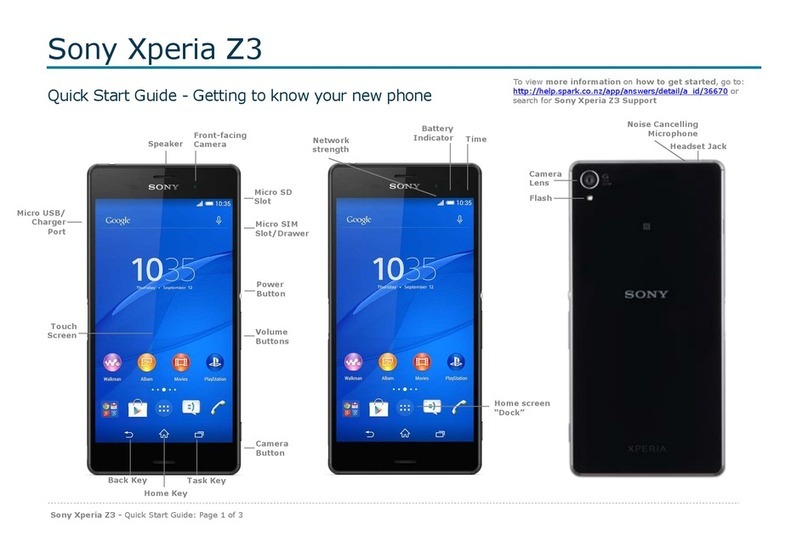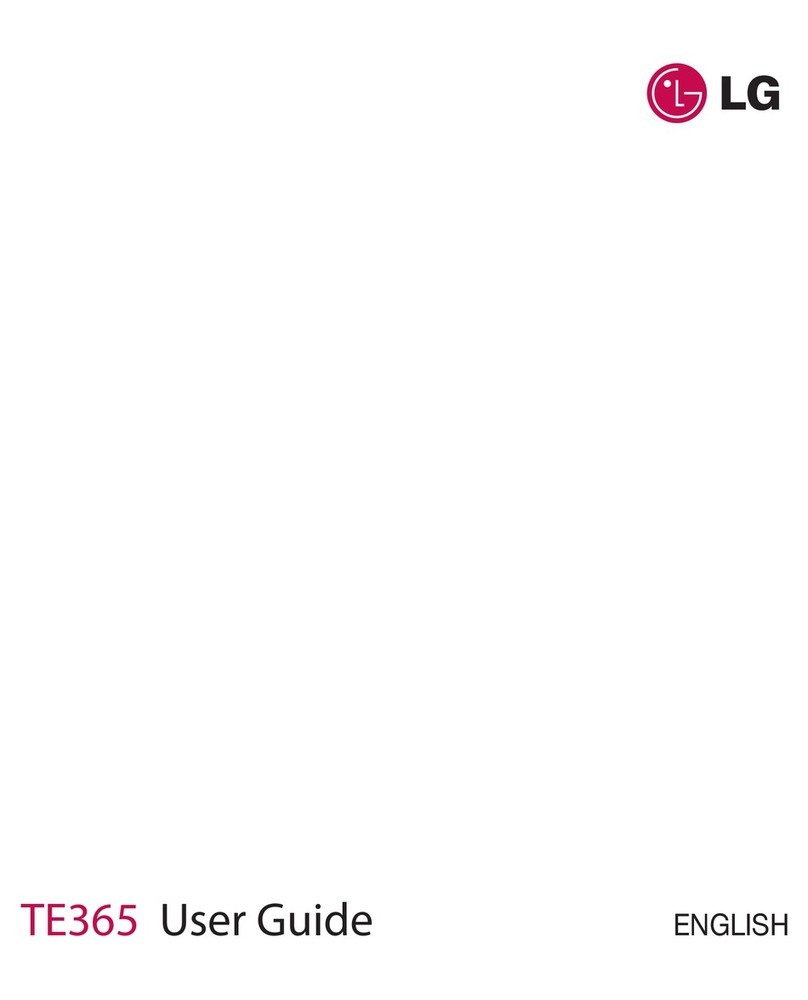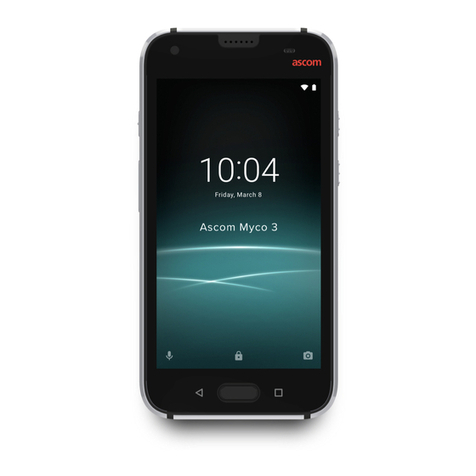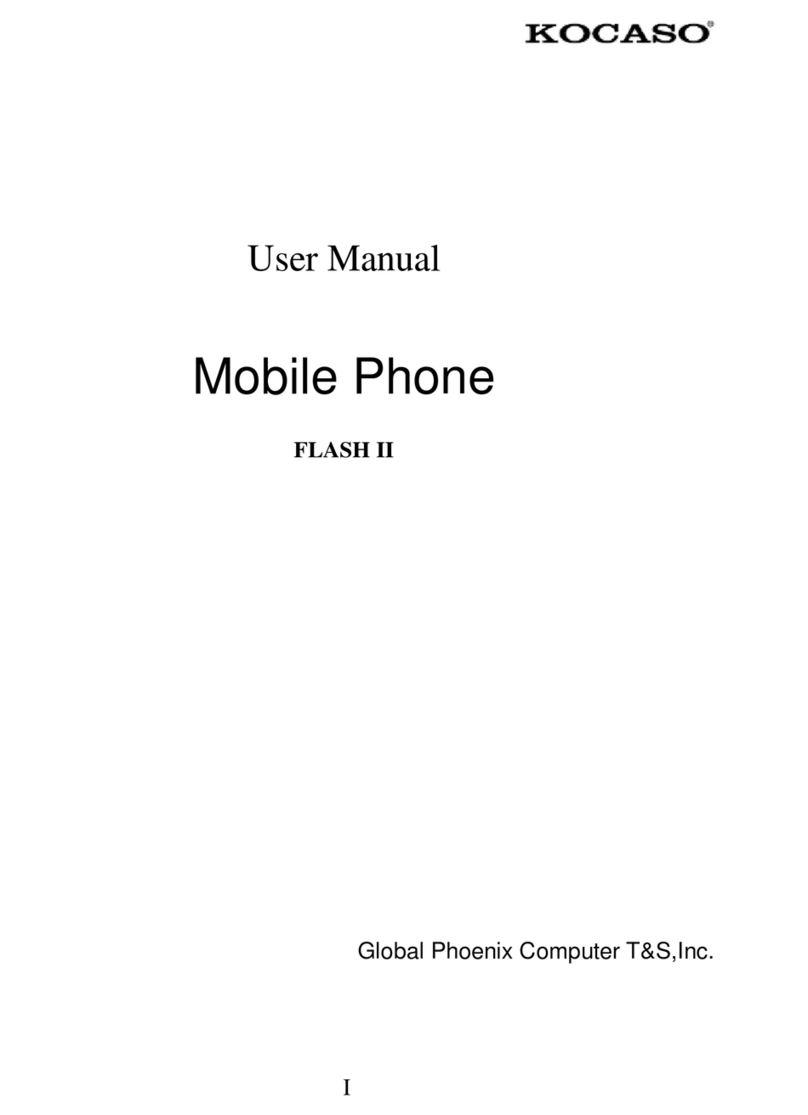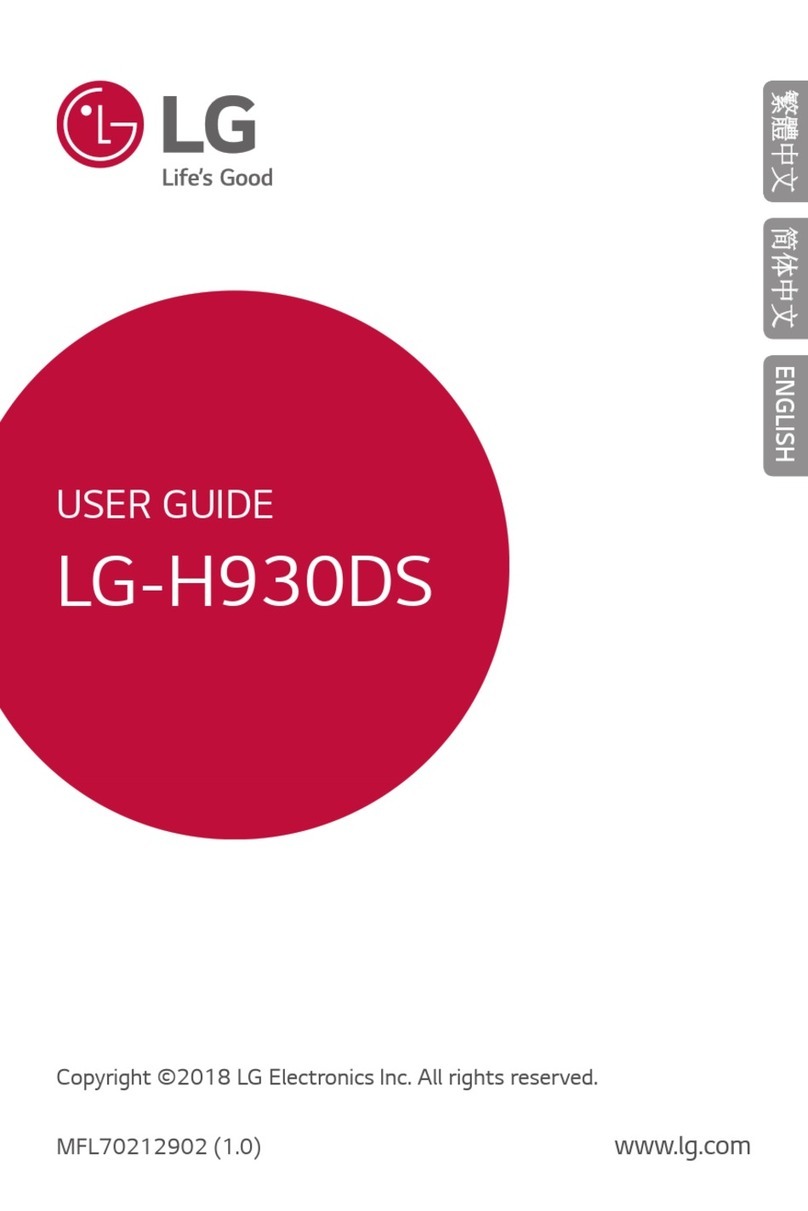Telular TELGUARD DIGITAL TG-1 User manual

56034002 1/9/2006 © 2006 Telular Corporation
TELGUARD® DIGITAL
TG-1
Residential Primary Cellular Alarm Communicator
Cellular Alarm Transmission System
Using GSM Digital Cellular Technology
MODEL TG1G0001
INSTALLATION AND OPERATING INSTRUCTIONS
COMPANY CONFIDENTIAL
For use by TELGUARD®customers only.
Distribution to others strictly prohibited.
Revised January 9, 2006
TELGUARD®is a registered trademark of Telular Corporation. Products are
protected under one or more of the following U.S. patents:
4,658,096 4,737,975 4,775,997 4,868,519 4,922,517
© 2006 Telular Corporation
C
O
R
P
O
R
A
T
I
O
N
®
Corporate Headquarters
647 North Lakeview Parkway
Vernon Hills, Illinois 60061
847-247-9400 Fax: 847-247-0021
T E L U L A R

56034002 1/9/2006 ii © 2006 Telular Corporation
FOREWORD
Many customers purchase the TelguardDigital because they prefer its price and features. The Telguard model
TG1G0001 is UL Listed for Household Fire systems and Household Burglary systems. This means that the
TG1G0001 may be used in Household Burglary systems, Household Fire systems or combined Household
Burglary & Fire system as the main communication line. The TG1G0001 may not be used in applications that
require UL Grade A Burglary or Fire Listings.

56034002 1/9/2006 iii © 2006 Telular Corporation
NOTICES
ABOUT THIS MANUAL
This manual assumes that you have basic security system installation skills such as
measuring voltages, stripping wire, properly connecting wires together, connecting wires to
terminals, and checking phone lines. It also assumes that you have a familiarity with the
proper installation and programming tasks related to various control communicator panels.
The material and instructions covered in this manual have been carefully checked for
accuracy and are presumed to be reliable. However, Telular assumes no responsibility for
inaccuracies and reserves the right to modify and revise this manual without notice.
It is our goal at Telular to always supply accurate and reliable documentation. If a
discrepancy is found in this documentation, please mail or fax a photocopy of the corrected
material to:
Telular Security Products
Technical Services Department
420 Thornton Road, Suite 109
Lithia Springs, GA 30122
Fax: 678-945-1651
© 2006 Telular Corporation. Lithia Springs, GA U.S.A. All rights reserved.
FCC NOTICES
EXPOSURE TO RADIO FREQUENCY ENERGY
In 1991, the Institute of Electrical and Electronics Engineers (IEEE), and in 1992, the American National
Standards Institute (ANSI), updated the 1982 ANSI Standard for safety levels with respect to human
exposure to RF energy. Over 120 scientists, engineers and physicians from universities, government health
agencies and industry, after reviewing the available body of research, developed this updated Standard. In
March 1993, the U.S. Federal Communications Commission (FCC) proposed the adoption of this updated
Standard.
The design of your Telular Telguard complies with this updated Standard. Of course, if you want to limit RF
exposure even further than the updated ANSI Standard, you may choose to install the unit in a manner that
locates its antenna at an even greater distance from the general public than is recommended as a minimum
by the standard.
To insure compliance with the standard, when selecting a mounting location for your Telguard do not mount
it (or its associated antenna) in an area where the general public could reasonably be within 8 inches (20
centimeters) of the antenna.
EFFICIENT OPERATION
Do not operate your Telular product when holding the antenna. Be sure to mount the unit such that its
antenna is a minimum of eight (8) inches (20 centimeters) is maintained from the general public.
For the best service quality, keep the antenna free from obstructions and point the antenna straight up.

56034002 1/9/2006 iv © 2006 Telular Corporation
ANTENNA CARE AND REPLACEMENT
Do not use the unit with a damaged antenna. If a damaged antenna comes into contact with the skin, a minor
burn may result. Have your antenna replaced by a qualified technician immediately. Use only a manufacturer-
approved antenna. Non-approved antennas, modifications, or attachments could impair service quality,
damage the Telguard and violate FCC regulations.
ELECTRONIC DEVICES
Most modern electronic equipment is shielded from RF energy. However, RF energy from cellular devices
may affect inadequately shielded electronic equipment. RF energy may affect improperly installed or
inadequately shielded electronic equipment operating in homes and businesses. Check with the manufacturer
or its representative to determine if these systems are adequately shielded from external RF energy. Consult
the manufacturer of any personal medical devices (such as pacemakers, hearing aids, etc.) to determine if
they are adequately shielded from external RF energy.
BLASTING AREAS
To avoid interfering with blasting operations, turn OFF your unit when in a “blasting area” or in areas posted:
“Turn off two-way radio.” Construction crews often use remote control RF devices to set off explosives.
POTENTIALLY EXPLOSIVE ATMOSPHERES
Turn OFF your unit when in any area with a potentially explosive atmosphere. It is rare, but your Telguard
Digital or its accessories could generate sparks. Sparks in such areas could cause an explosion or fire
resulting in bodily injury or even death. Areas with a potentially explosive atmosphere are often, but not
always, clearly marked. They include fueling areas such as gas stations; below deck on boats; fuel or
chemical transfer or storage facilities; areas where the air contains chemicals or particles, such as grain, dust,
or metal powders; and any other area where you would normally be advised to turn off your vehicle engine.
Do not transport or store flammable gas, liquid or explosives in the area of your Telguard Digital or
accessories.
Vehicles using liquefied petroleum gas (such as propane or butane) must comply with the National Fire
Protection Standard (FPA-58). For a copy of this standard, contact the National Fire Protection Association,
One Batterymarch Park, Quincy, MA 02269, Attn: Publications Sales Division.
REPAIR AND WARRANTY
If trouble is experienced with the Telguard
Cellular Alarm Transmission System please contact Telular
Technical Service in the U.S.A. for repair and (or) warranty information.
Telular Security Products
TECHNICAL SERVICES DEPARTMENT
420 Thornton Road, Suite 109
Lithia Springs, GA 30122
Phone: (800) 229-2326
The customer (user) should not attempt any repair to the Telguard
Cellular Alarm Transmission System.
Repair of this equipment should be referred to only qualified technical personnel.

56034002 1/9/2006 v© 2006 Telular Corporation
FUTURE TESTING AND LIMITATIONS ON USE
Telguardis part of an advanced design alarm-communication system. It does not offer guaranteed
protection against burglary and fire. Any alarm communication system is subject to compromise or failure.
The Telguardwill not work without power. Devices powered by AC will not work if the AC power supply is
off for any reason, however briefly, and at the same time the backup battery is missing, dead or not properly
installed.
The cellular radio network, needed to transmit alarm signals from a protected premises to a central monitoring
station, may be inoperable or temporarily out of service. Cellular radio networks are also subject to
compromise by sophisticated methods of attack.
This equipment, like any other electrical device is subject to component failure. Although this equipment is
designed to be long lasting, the electrical components could fail at any time.
Due to these limitations, we recommend that if the automatic self-test feature is not enabled, other
arrangements be made with the user to test the system at least once every three months. Moreover,
arrangements should also be made for on-site inspection/test by a licensed alarm installer at least once each
year.
TERMS AND CONDITIONS FOR USE OF TELGUARD®PRODUCTS (“PRODUCT”)
These Terms and Conditions are a legal contract between you and Telular Corporation for the title to and use
of the Product. BY RETAINING AND USING THE PRODUCT YOU AGREE TO THE TERMS AND
CONDITIONS INCLUDING WARRANTY DISCLAIMERS, LIMITATIONS OF LIABILITY AND
INDEMNIFICATION PROVISIONS BELOW. IF YOU DO NOT AGREE TO THE TERMS AND
CONDITIONS, DO NOT USE THE PRODUCT AND IMMEDIATELY RETURN THE UNUSED PRODUCT
FOR A COMPLETE REFUND. You agree to accept sole responsibility for any misuse of the Product by you;
and, in addition, any negligent or illegal act or omission of your or your agents, contractors, servants,
employees, or other users of the Product so long as the Product was obtained from you, in the use and
operation of the Product.
INDEMNIFICATION OF TELULAR CORPORATION (“TELULAR”)
YOU SHALL INDEMNIFY, DEFEND AND HOLD HARMLESS TELULAR FOR ANY OF THE COST,
INCLUDING REASONABLE ATTORNEYS’ FEES, AND FROM CLAIMS ARISING OUT OF YOU, YOUR
CLIENTS’ OR OTHER THIRD PARTIES’ USE OR OPERATION OF THE PRODUCT: (i) FOR MISUSE OR
IN A MANNER NOT CONTEMPLATED BY YOU AND TELULAR OR INCONSISTENT WITH THE
PROVISIONS OF THIS MANUAL; (ii) IN AN ILLEGAL MANNER OR AGAINST PUBLIC POLICY; (iii) IN A
MANNER SPECIFICALLY UNAUTHORIZED IN THIS MANUAL; (iv) IN A MANNER HARMFUL OR
DANGEROUS TO THIRD PARTIES; (v) FROM CLAIMS BY ANYONE RESPECTING PROBLEMS,
ERRORS OR MISTAKES OF THE PRODUCT; OR (vi) COMBINATION OF THE PRODUCT WITH
MATERIAL, MODIFICATION OF THE PRODUCT OR USE OF THE PRODUCT IN AN ENVIRONMENT
NOT PROVIDED, OR PERMITTED, BY TELULAR IN WRITING. THE PARTIES SHALL GIVE EACH
OTHER PROMPT NOTICE OF ANY SUCH COST OR CLAIMS AND COOPERATE, EACH WITH THE
OTHER, TO EFFECTUATE THIS INDEMNIFICATION, DEFENSE AND HOLD HARMLESS.
WARRANTY; LIMITATIONS
TELULAR WILL REPAIR OR REPLACE (OUR OPTION) INOPERATIVE UNITS FOR UP TO TWO YEARS
FROM DATE OF MANUFACTURE. EXCLUDES DAMAGE DUE TO LIGHTNING OR INSTALLER ERROR AS
WELL AS UNITS THAT INCORPORATE MATERIAL, OR USED IN A MANNER OR ENVIRONMENT, NOT
SPECIFICALLY AUTHORIZED IN THIS MANUAL. UNAUTHORIZED MODIFICATIONS VOID THIS
WARRANTY. NOT RESPONSIBLE FOR INCIDENTAL OR CONSEQUENTIAL DAMAGES. LIABILITY
LIMITED TO PRICE OF UNIT. THIS IS THE EXCLUSIVE WARRANTY, IN LIEU OF ALL OTHER
WARRANTIES INCLUDING IMPLIED WARRANTIES OF MERCHANTABILITY, TITLE, DELIVERY,
INFRINGEMENT OR FITNESS FOR A PARTICULAR PURPOSE AND NO OTHER WARRANTIES WILL BE
HONORED, WHETHER EXPRESSED OR IMPLIED.

56034002 1/9/2006 vi © 2006 Telular Corporation
TABLE OF CONTENTS
FOREWORD .................................................................................................................................................II
NOTICES ....................................................................................................................................................III
ABOUT THIS MANUAL ............................................................................................................................III
FCC NOTICES .............................................................................................................................................III
EXPOSURE TO RADIO FREQUENCY ENERGY ...................................................................................III
EFFICIENT OPERATION.........................................................................................................................III
ANTENNA CARE AND REPLACEMENT................................................................................................ IV
ELECTRONIC DEVICES......................................................................................................................... IV
BLASTING AREAS.................................................................................................................................. IV
POTENTIALLY EXPLOSIVE ATMOSPHERES ...................................................................................... IV
REPAIR AND WARRANTY ..................................................................................................................... IV
FUTURE TESTING AND LIMITATIONS ON USE....................................................................................... V
TERMS AND CONDITIONS FOR USE OF TELGUARD® PRODUCTS (“PRODUCT”) ......................... V
INDEMNIFICATION OF TELULAR CORPORATION (“TELULAR”) ........................................................ V
WARRANTY; LIMITATIONS .................................................................................................................... V
1.0 GENERAL DESCRIPTION AND OPERATION..................................................................................1
2.0 FEATURES ........................................................................................................................................1
2.1 OPERATING MODE.......................................................................................................................1
2.2 C/C COMMUNICATION FORMATS...............................................................................................1
2.3 COMPLETE SUPERVISION OF COMMUNICATION PATH .........................................................1
2.3.1 NO SERVICE CONDITION (NSC)...........................................................................................2
2.3.2 RADIO COMMUNICATIONS FAILURE CONDITION (RFC)...................................................2
2.4 COMPLETE POWER SUPERVISION............................................................................................2
2.4.1 LOW/MISSING BATTERY CONDITION (LBC) .......................................................................2
2.4.2 AC FAILURE CONDITION (ACFC) .........................................................................................2
2.4.3 DIAL TONE FAILURE (DTF) ...................................................................................................2
2.4.4 CATASTROPHIC FAILURE (CF) ............................................................................................2
2.5 TELGUARD AUTOMATIC SELF-TEST REPORT .........................................................................2
2.5.1 TELGUARD REMOTE QUERY CAPABILITY .........................................................................3
2.6 TELGUARD TERMINAL STRIP CONNECTIONS..........................................................................3
2.6.1 PROGRAMMABLE SUPERVISORY TRIP OUTPUT (STC) RELAY ......................................3
2.7 DIAGNOSTIC AND STATUS LEDS ...............................................................................................4
2.7.1 LED SIGNAL STRENGTH INDICATION .................................................................................4
2.8 TELGUARD SETUP PROGRAMMING PARAMETERS ................................................................5
2.9 UL LISTINGS..................................................................................................................................5
3.0 GETTING READY ..............................................................................................................................5
3.1 DEALER ACCOUNT ESTABLISHMENT .......................................................................................5
3.2 SUBSCRIBER ACCOUNT ACTIVATION.......................................................................................5
3.3 PRE-INSTALLATION CHECKLIST ................................................................................................6
4.0 INSTALLATION SUMMARY ..............................................................................................................6
4.1 ACTIVATE & REGISTER TELGUARD ON CELLULAR NETWORK.............................................6
4.2 TRANSMIT C/C ALARMS OVER THE CELLULAR RADIO NETWORK .......................................6
4.3 CONNECT SUPERVISORY TRIP OUTPUT..................................................................................6
4.4 COMPLETE THE INSTALLATION .................................................................................................6
5.0 INSTALLATION STEPS .....................................................................................................................7
5.1 STEP 1: ACTIVATE & REGISTER THE TELGUARD UNIT .........................................................7

56034002 1/9/2006 vii © 2006 Telular Corporation
5.1.1 ACTIVATE CELLULAR SERVICE ...........................................................................................7
5.1.2 LOCATE UNIT .........................................................................................................................7
5.1.3 CONNECT BACKUP BATTERY AND AC POWER TRANSFORMER ...................................7
5.1.4 CONNECT ANTENNA AND TEMPORARILY PLACE UNIT ...................................................7
5.1.4.1 TIPS FOR IMPROVED RADIO SIGNAL RECEPTION.......................................................... 8
5.1.5 MEASURE RECEIVED SIGNAL STRENGTH (RSSI) FOR BEST ANTENNA PLACEMENT 8
5.1.5.1 ANTENNA OPTIONS ............................................................................................................. 8
5.2 STEP 2: CONNECT C/C TO TELGUARD JACK 7 ........................................................................8
5.3 STEP 3: PROGRAM THE TELGUARD FOR ALARM TRANSMISSION .......................................8
5.3.1 SETUP & PROGRAMMING THE OPERATING PARAMETERS IN THE TELGUARD ...............9
5.3.1.1 COMMAND KEY SEQUENCES FOR POTS PROGRAMMING............................................ 9
5.3.2 COMPLETE THE TELGUARD PROGRAMMING DATA SHEET..........................................10
5.3.3 VERIFY ALARM SIGNAL TRANSMISSIONS OVER CELLULAR ........................................10
5.4 STEP 4: CONNECT SUPERVISORY TRIP OUTPUTS...............................................................10
5.4.1 DECIDE ON A STC TRIP OUTPUT STRATEGY..................................................................11
5.4.2 CHECK TELGUARD SUPERVISORY TRIP TO C/C ............................................................11
5.4.2.1 REPROGRAM C/C TO SEND PROPER CODE.................................................................. 11
5.4.2.2 CHECK PROPER OPERATION OF TELGUARD SUPERVISORY OUTPUT .................... 11
5.5 STEP 5: COMPLETE THE TELGUARD INSTALLATION............................................................11
5.5.1 CHECK SETTINGS................................................................................................................11
5.5.2 PERMANENTLY MOUNT AND PROPERLY GROUND THE TELGUARD CHASSIS .........11
A1.0 APPENDICES..................................................................................................................................12
A1.1 WIRING DIAGRAM ......................................................................................................................12
A1.2 JACK AND PIN ASSIGNMENTS..................................................................................................13
A1.3 TERMINAL STRIP PIN ASSIGNMENTS......................................................................................13
A1.4 LED MODES AND FUNCTIONS..................................................................................................14
A2.0 OPERATIONAL QUICK REFERENCE TABLE................................................................................15
A2.1 ACTIVATION FORM.....................................................................................................................16
A2.2 COMPATIBLE CONTROL COMMUNICATORS ..........................................................................17
A3.0 DETAILED SPECIFICATIONS ..........................................................................................................17
A3.1 DIALER TO INTERFACE ELECTRONICS...................................................................................17
A3.2 POWER ........................................................................................................................................17
A3.3 DIGITAL CELLULAR RADIO........................................................................................................17
A3.4 WARRANTY .................................................................................................................................17
A4.0 PARTS LIST .....................................................................................................................................18
GENERAL ACCESSORIES ........................................................................................................................18

56034002 1/9/2006 1© 2006 Telular Corporation
1.0 GENERAL DESCRIPTION AND OPERATION
The Telguardmodel TG-1 is a digital cellular radio alarm transmission device used to provide a primary
transmission path (cellular) for Household control communicators (C/Cs). When transmitting an alarm
signal, Telguard obtains its data from the C/C by way of a telco interface. The Telguard will obtain all
alarm signal information including monitoring station phone number, account number and all zones for
every alarm transmission. The Telguard transmits a Link Request to the Telular Communication Center
and when a link acknowledgement is received, the Telguard handshakes with the C/C and causes the
C/C to transmit the alarm data. Telguard encodes the alarm data into SMS (Short Messaging System)
protocol and transmits to the local digital cellular network provider. The signal is routed from the network
provider to the decoding Telular Communication Center. The Telular Communication Center performs a
function similar to a central station receiver and issues the transmission acknowledgement when the last
message in the transmission is received. After decoding and reformatting, the alarm signal is routed over
the telco line (Public Switched Telephone Network - PSTN) to the appropriate alarm company central
station for action.
In a typical alarm installation, Telguard Digital TG-1 is installed in the same area as the host alarm system
and is connected directly to the host C/C digital dialer via the Telguard’s TG-45 jack in the normal fashion.
One programmable supervisory trip (STC) output is available for connection to the host
control/communicator's trip zone input terminals in order to provide a Telguard trouble signal to the C/C.
Additionally, automatic self-test and status-on-demand report signals are transmitted exclusively over the
cellular network to the Telular Communication Center. Telguard has its own internal power supply/battery
charger. All cellular monitoring and supervisory functions are built in. No extra modules are required.
The Listed equipment at the Telular Communication Center (TCC) plays a key role in the operation of every
Telguard. All Telguard units are required to use the Communication Center because of the C/C alarm signal
format encoding and decoding requirements used in packet-data transmissions over the digital cellular
network. The Communication Center also manages the real-time databases for cellular activation and a
complete history of every Telguard's operating conditions. These conditions include programming setup
information, cellular alarm transmission information, supervisory trouble information, status-on-demand
information, and automatic self-test information.
2.0 FEATURES
This section summarizes the key features of the Telguard Digital TG-1. Actual installation instructions
begin in Section 5.0.
2.1 OPERATING MODE
The Telguard Digital TG-1 is a digital cellular SMS transmission device that is installed at the protected
premises to provide primary alarm transmission integrity for household burglary and fire systems. It is
used to provide a primary transmission path (cellular) for control communicators (C/Cs).
2.2 C/C COMMUNICATION FORMATS
The Telguard reads the C/C’s alarm messages and converts the C/C’s Ademco Contact ID handshake
data format into SMS packet data protocol for transmission over the cellular radio network. In order for
the C/C to be compatible with the Telguard, the C/C must be programmed to transmit alarm messages to
the central station using Ademco Contact ID format. Contact ID format requires a four-digit account
number using digits 0-9 (0001-9999).
2.3 COMPLETE SUPERVISION OF COMMUNICATION PATH
The Telguard Digital TG-1 continuously supervises the primary (cellular) communication path. If the
cellular communications path becomes inoperative, the Telguard generates a relay trip output that can be
connected to a zone input of the host control communicator and/or used to activate remote sounding
devices.

56034002 1/9/2006 2© 2006 Telular Corporation
2.3.1 No Service Condition (NSC)
Telguard declares a no service condition (NSC) when the measured “receive” cellular radio signal
strength at the protected premises drops to -114 dBm or less. NSC is programmable to trip the
supervisory relay output (STC relay) after a 30 or 60 second delay. When STC relay trips, the
STC LED will flash 4 times. Restoral of this condition occurs when a measurable signal strength
greater than –114 dBm is maintained for the trip period of 30 or 60 seconds.
2.3.2 Radio Communications Failure Condition (RFC)
Radio communications failure condition (RFC) is declared when Telguard is unable to transmit
over the cellular network even with acceptable signal strength. RFC is indicated by the STC
(System Trouble Condition) LED flashing 5 times.
2.4 COMPLETE POWER SUPERVISION
Telguard monitors its backup battery as well as its AC power source and reports power conditions from
either. Telguard’s integrated control and power module incorporates a battery charging circuit that is
programmable for various battery capacities. Battery charger circuit is monitored.
2.4.1 Low/Missing Battery Condition (LBC)
The Telguard checks the backup battery voltage on initial power-up and every 60 seconds thereafter. If
the battery voltage changes from ‘good’ to ‘bad’ state and is less than 11.6 volts, a LBC is declared
whereby the STC LED blinks twice (every 5 seconds) and the STC relay trips. When the battery voltage
increases to 12.1 volts, the STC LED and STC relay restore. Telguard also indicates Low/missing Battery
Condition (LBC) when battery charger fails.
2.4.2 AC Failure Condition (ACFC)
AC failure condition (ACFC) is detected immediately (not programmable). The AC Power LED
goes out immediately, the STC LED blinks once and the STC trip output is activated after 2
hours. When AC power returns to normal (≥106 VAC for 60 seconds), the AC Power LED turns
on immediately and the STC trip output restores after 60 seconds.
2.4.3 Dial Tone Failure (DTF)
The Telguard continuously monitors the 30V sully circuit that provides dial tone to the C/C. A Dial
Tone Failure (DTF) is declared when the 30V supply drops to 20V or less while the C/C is on-
hook. The STC LED will flash 6 times and the STC relay will trip. Additionally, a TYPE 2
supervisory message is automatically transmitted to the Telular Communications Center. This
condition represents a catastrophic failure and will require contacting the Telular Communications
Center for resolution.
2.4.4 Catastrophic Failure (CF)
Catastrophic Failure (CF) is any condition that causes the Telguard to stop functioning at all
levels. Most commonly because of AC power failure followed by a complete discharge of the
backup battery. The STC trip output is activated and visible indication is loss of all LED activity.
2.5 TELGUARD AUTOMATIC SELF-TEST REPORT
The Telguard automatic self-test signal is programmed to daily, weekly or monthly schedule as prescribed
by contract. The central station receives the automatic self-test report in the same format that the C/C
normally uses for communication over the telco line. The central station provides the Telguard self-test
code along with the time and frequency of transmission when the Telguard is initially activated. The
Communication Center captures all current and historical data pertaining to the operation of the Telguard
when it processes the automatic self-test signal on to the central station. This data contains current
operational status (C.O.S.) of the Telguard such as "All OK", "AC fail condition", "low/missing battery
condition", or any combination of these as well as the current signal strength. In addition, the data also
contains historical data for supervisory events that occurred since the last self-test signal was transmitted.
This data includes the number of occurrences of AC fail conditions, low battery conditions, line fault
conditions, communications failure conditions and no cellular service conditions. This additional
information is available by contacting Telular Technical Support.

56034002 1/9/2006 3© 2006 Telular Corporation
2.5.1 Telguard Remote Query Capability
Although Telguard has the capability for a daily, weekly, or monthly automatic self-test, a separate
feature is provided for determining the current operational status of every Telguard. This feature is
called Remote Query and is used to provide real-time operational status for Telguard on-demand. It
is useful in resolving STC events that are reported by the C/C to the central station. Authorized
personnel can initiate the Remote Query at any time by calling Customer Service. The Remote
Query causes Telguard to upload current operational status data and historical data, just as the
automatic self-test described above, except that the query signal is controlled by the one who initiates
it. The query signal is held in the Telguard database at the Communication Center for review and is
not forwarded on to the central station.
2.6 TELGUARD TERMINAL STRIP CONNECTIONS
The conveniently located terminal strips provides wiring connections for the Telguard supervisory trip outputs,
battery leads for connecting to a 12 volt 4.0Ah, or 7.0AH rechargeable battery, and AC power. The terminal
strip can accommodate solid or stranded wire sizes from 14 to 22 gauge.
2.6.1 Programmable Supervisory Trip Output (STC) Relay
The Telguard Digital TG-1 has one supervisory relay trip output (STC) and is energized in a powered-
up state when no system troubles exist. It enables a supervisory trouble code to be transmitted to the
central station when connected to a C/C’s 24-hour instant input zone. The STC relay is
programmable, using a standard touch-tone telephone or butt-set, to meet virtually any installation
requirement.
The following supervisory features or combination of features are programmable to trip the STC
relays in order to meet a variety of installation requirements:
• Trips on AC fail condition (ACFC)
• Trips on low or missing battery condition (LBC).
• Trips on no service condition (NSC).
• Trips on radio communication failure condition (RFC).
The following system trouble features are embedded in the Telguard for tripping the STC relay and
cannot be changed:
• Tripped when unit is not registered with the Telular Communications Center (TCC)
• Trips on catastrophic failure (CF) if all power is lost.
• Trips on transmit-disable command from the Communication Center. This radio command
disables only the Telguard transmitter and would be used, for example, to shut down the
Telguard due to a runaway dialer.

56034002 1/9/2006 4© 2006 Telular Corporation
2.7 DIAGNOSTIC AND STATUS LEDS
Six LEDs are provided as a useful aid during installation and give installers an immediate visual indication of
system status.
LED Function Table – Normal Operating Mode (J10 = OPEN)
LED Symbol Color Duty Cycle Indication
LED 6 RED Solid On AC power connected to unit
LED 1 Solid On Unit is registered with the message center and enabled
Registration Off Unit not registered with message center (and disabled)
Green
Flashing Unit is registered but disabled
LED 2 Off ALL OK
STC 1 Flash* System Trouble Condition – Low/Missing AC Power
2 Flashes* System Trouble Condition – Low/Missing Battery Condition
AND/OR Battery Charger Failure
3 Flashes* Not used
4 Flashes* System Trouble Condition – NSC
5 Flashes* System Trouble Condition – RFC
RED
6 Flashes* System Trouble Condition – DTF
Off Mode 2, Cell Priority (normal operation)
On Mode 1, N/A for TG-1
LED 3
MODE
Yellow
Fast Flash C/C off-hook to transmit signals over cellular.
LED 4
Acknowledgement
Solid On Telguard TG-1 waiting for acknowledgement from
Communication Center
Off Idle state
Red
Flashing When flashing with LED 1 unit has failed registration due to the
programming of the panel, CALL TECH SUPPORT
LED 5 Off TG-1 initialized
On TG-1 initializing & registering with cellular network or
Transmitting Alarm Data
Short Flash (1 sec) Radio receiving message
Green
Long Flash (2 sec) Radio sending message
2.7.1 LED Signal Strength Indication
The Telguard provides the installer with an easy to use LED radio signal strength indicator (RSSI) for
positioning the unit or remote antenna to obtain the strongest RF signal possible. A signal strength
reading can be obtained at any time there is power applied to the Telguard without affecting the
operation of the unit. When the “RSSI” jumper J10 is “SHORTED”, the Telguard displays the current
received signal strength within 5 seconds. The signal strength is read from left to right using the four
sequential LEDs located on the top right side of the printed circuit board with the Radio TX LED = 5
and the STC LED = 2. See Appendix A1.4 for RSSI table.

56034002 1/9/2006 5© 2006 Telular Corporation
2.8 TELGUARD SETUP PROGRAMMING PARAMETERS
The Telguard will not operate until the unit is activated from the Telular Communication Center.
Certain Telguard operating parameters may need to be changed from the factory default programming by the
installer during installation in order to have the Communication Center process alarm signals to the central
station. These setting include the STC supervisory trip input settings, CFC settings, NSC trip delay time, and
standby battery size. The Communication Center responds with a radio acknowledgement to the Telguard
clearing the STC condition and allowing the Telguard to operate over the cellular radio network. The
programmed parameters are transmitted automatically to the Telular Communication Center when the
Telguard is activated.
2.9 UL LISTINGS
Model TG1G0001 meets the requirements for all Household Burglary, Household Fire, and Combined
Household Burglary/Fire installations. TG1G0001 has a plastic enclosure and dipole antenna. TG1G0001 is
UL Listed for the following:
• UL Household Burglary
• UL Household Fire
• UL Household Burg/Fire Combination
3.0 GETTING READY
The Telguard can only be activated when all the necessary accounting information has been entered into the
customer database located at the Telular Communication Center. The database includes information about
the customer account, unit location, and system test plan information.
3.1 DEALER ACCOUNT ESTABLISHMENT
Prior to activation of any Telguard unit, a Dealer Account must be established. Once the Dealer Account has
been established and service credit line established between the Security Dealer and Telular, a Cellular
Service Activation form may be submitted. Establish your Dealer Account by completing the Telular Cellular
Service Dealer Account Application that is included with every Telguard and faxing it to Telular Customer
Service at 678-945-1651. Once the application has been completed you will receive an acknowledgment
within 1 business day or sooner. This is a one-time event; the acknowledgment from the Telular Customer
Service will include a Dealer Account Number that will be used for all Telguard Digital activations.
3.2 SUBSCRIBER ACCOUNT ACTIVATION
Activate Telguard prior to leaving for the job site. Activation of the Telguard can be accomplished by
either of the two following methods:
1. FAX - Fax the completed Telular Cellular Service Activation Form that is shipped with each Telguard
to Telular Customer Service at 678-945-1651.
2. INTERNET - Complete the Activation Form online at www.Telguard.com
Within 30 minutes of receipt of the activation request, the subscriber record will be created and billing of
service will commence. Telular Customer Service is open from 8:00 AM – 8:00 PM EST Monday – Friday,
9:00 AM – 1:00 PM EST Saturday and closed during major holidays; Activation requests received after hours
will be processed by 9:00 AM EST the next business day.

56034002 1/9/2006 6© 2006 Telular Corporation
3.3 PRE-INSTALLATION CHECKLIST
Before attempting to connect Telguard to the host C/C, please note the following:
1. Be sure you have all the proper parts before you go to the job site. The following items are shipped with each
Telguard unit:
Activation Form – Complete the Activation Form online at www.Telguard.com or fax your activation form
to TCS (Telular Cellular Service) prior to leaving for the job site. Activations take place Monday-Friday
during business hours and Saturdays from 9:00AM – 1:00PM EST.
Basic Telguard unit in a plastic enclosure.
UL Listed plug-in transformer.
Antenna
3-foot modular plug-to-plug cord for connecting Telguard to C/C.
Telguard Installation and Operating Instructions Manual
Backup Battery must be provided by installer.
2. You must also have certain installation test tools.
• A standard telephone or lineman's butt-set is required at the job site for use in programming the unit.
• Optimal signal strength is determined by placing the unit and antenna where the most LEDs (up to
four) are lighted when using Telguard's on-board Signal Strength Indicator feature so that the unit can
be easily placed during installation where signal strength is greatest. Upon location selection, screws
and a screwdriver will be required to attach the unit and antenna to the wall.
NOTE: Your unit may be subject to airtime charges for unintended use. Telular Cellular Service
(TCS) offers several cellular service rate plans. Check the Activation form that was shipped with
your unit or call us to determine what rate plan each unit is operating under.
3. Confirmation from the Telular Communications Center that the Telguard Digital unit is ready for installation
and registration. Registration is the process of establishing communications from the Alarm Panel to the
Telular Communication Center.
4.0 INSTALLATION SUMMARY
There are five steps in installing Telguard properly. IF YOU DO NOT PROCEED IN THE ORDER AND
MANNER PRESCRIBED, YOU MAY NOT COMPLETE THE INSTALLATION IN THE TIME ALLOCATED.
These five steps are summarized below and then explained in detail in the remainder of this manual.
4.1 ACTIVATE & REGISTER TELGUARD ON CELLULAR NETWORK
Complete the activation form online at www.Telguard.com or fax the activation form that is included with the product
to Telular Cellular Service to activate cellular service. Activation takes approximately 30 minutes during business
hours. Registration occurs automatically upon power up of the unit. This should be accomplished prior to leaving for the
job site.
4.2 TRANSMIT C/C ALARMS OVER THE CELLULAR RADIO NETWORK
Next, you will be connecting the C/C's digital dialer output to Telguard and verifying that alarm signals can be
reliably sent through Telguard over cellular to the central station digital receiver. NOTE: the first alarm registers
the Telguard with the Telular Communication Center and will not be transmitted to the Central Station.
4.3 CONNECT SUPERVISORY TRIP OUTPUT
Telguard's supervisory trip output is connected to the C/C and then tested.
4.4 COMPLETE THE INSTALLATION
Your last step will be to check the jumper setting of J10 (LED mode, open = normal), attach earth ground, and
permanently mount the unit.
* * * *
With this overview of the installation in mind, you should now proceed with the actual installation, following the
steps described in the remainder of this manual.

56034002 1/9/2006 7© 2006 Telular Corporation
5.0 INSTALLATION STEPS
This five-step installation approach (5.1 through 5.5) provides the alarm installer with the easiest and fastest
method of properly installing Telguard. Please follow the instructions carefully and if you should need
assistance or have any questions, call Telular TECHNICAL SUPPORT at 1-800-229-2326 extension 9.
NOTE: Dealer Account Establishment and Cellular Activation must be complete prior to Installation
(see section 3.0)
5.1 STEP 1: ACTIVATE & REGISTER THE TELGUARD UNIT
Installation Tip: Activate cellular service prior to leaving for the job site to avoid a second trip.
5.1.1 Activate Cellular Service
Complete the activation form online at www.Telguard.com or Fax the activation form that is included
with the product to Telular Cellular Service to activate cellular service. Service activation takes place
Monday-Friday from 8:00AM to 8:00PM and Saturday 9:00AM to 1:00PM EST. Service activation
occurs within 30 minutes of receipt of the activation form. Registration occurs automatically upon
power up of the unit.
5.1.2 Locate Unit
Pick a spot next to the C/C where you think the Telguard will be mounted and place the unit down
temporarily in that spot. Do not mount it permanently now, since it may need to be moved to
receive a better cellular radio signal or a remote high-gain antenna may be necessary.
5.1.3 Connect Backup Battery and AC Power Transformer
To apply power to Telguard, attach battery leads to battery terminals noting polarity.
Connect the Telguard AC power transformer (see A3.2 for acceptable UL Listed transformers) to AC
terminals using stranded copper insulated wire following wire gauge and length recommendations below:
Recommended Wire Size Length Not to Exceed
18 ga 20 ft
16 ga 40 ft
14 ga 60 ft
5.1.4 Connect Antenna and Temporarily Place Unit
The Telguard is supplied with an antenna. In most cases the antenna may be mounted directly to the
Telguard. If a stronger radio signal is required, the antenna must be moved to a better signal location
using a Telular antenna cable and bracket accessory (sold separately). The characteristics of the
Telguard antenna can be altered depending upon the wall material and materials contained within the
wall chosen for mounting. These effects may not be clearly identified by RSSI monitoring alone. The
wall materials may have a more profound affect on the antennas transmit band performance.
When selecting a mounting location, do not mount this unit in an area where the general public could
reasonably be within 20cm (8 inches) of the antenna. The supplied dipole antenna is for INDOOR
USE ONLY.
Note 1: Optimum RF performance can usually be found at the highest point within a building with the
fewest number of walls between the Telguard’s antenna and the outside of the premises.
Note 2: To avoid interference with other electronic devices operating in the area, avoid mounting the
Telguard’s antenna near other electronic devices.
Note 3: The Telguard Digital TG-1 unit with supplied dipole antenna is designed for indoor installations.

56034002 1/9/2006 8© 2006 Telular Corporation
These considerations should be coupled with the best RSSI indication obtainable (see section 2.7.1).
Care should be taken to insure that a large metal object such as a refrigerator or a metal cabinet is
not located on the opposite side of the wall.
If moving the Telguard to a different location is not practical, then you may need a cable and remote the
antenna in order to receive adequate radio signal strength. Pick a high, visually secure spot using the
guidelines below.
5.1.4.1 Tips for Improved Radio Signal Reception
• The higher the antenna the better. So, start in the drop ceiling above the unit and proceed up from
there, to the roof if necessary.
• Remember, the antenna should be as inconspicuous as possible for greatest visual security.
• Try to keep the antenna away from sources of RF interference, including pumps, compressors,
ovens, etc., or where metal objects can shield it or otherwise block the cellular radio RF signal.
• Place the antenna perpendicular to the ground, either right side up or upside down. Do not mount
the antenna horizontally.
5.1.5 Measure Received Signal Strength (RSSI) for Best Antenna Placement
Measure the received signal strength by putting jumper J10 "SHORTED". This switches the LEDs to
signal strength mode. Now, slowly move the unit or remote antenna to achieve maximum signal
strength. Pick the place where the most LEDs (up to four) are lighted.
LED Function Table – View RSSI Mode
RSSI Value LED’s Lighted RF dBm
NO SVC LED 5 = slow flash, LED 4-2 = off n/a
1 LED 5 = on, LED 4-2 = off ≤-111 dBm
1½ LED 5 = on, LED 4 = slow flash
LED 3-2 = off
≥-110 dBm
2 LED 5-4 = on, LED 3-2 = off ≥-100 dBm
2½ LED 5-4 = on, LED 3 = slow flash
LED 2 = off
≥-90 dBm (Minimum signal
strength required)
3 LED 5-3 = on, LED 2 = off ≥-80 dBm
3½ LED 5-3 = on, LED 2 = slow flash ≥-70 dBm
4 LED 5-2 = on ≥-60 dBm
Note: LED 1 = on indicates more than one cellular tower.
NOTE: If you cannot obtain a signal strength reading of 2½ (TWO LEDS ON SOLID AND THE
THIRD LED ON SLOW FLASH), you will probably need to move the unit and/or remote antenna
higher, or switch to a special antenna as described below.
5.1.5.1 Antenna Options
Antenna problems are unlikely unless the premises are located in a fringe network coverage area, in a
building below ground level, or in a metal structure. If you require a higher gain antenna or a longer
cable assembly please contact your Telular Sales Representative at 800-229-2326. Telular offers a
variety of high quality low loss, dual band antenna cables and high gain antenna.
5.2 STEP 2: CONNECT C/C TO TELGUARD JACK 7
Plug the modular jack of the C/C-to-Telguard cable (supplied) from C/C to J7 on the Telguard.
5.3 STEP 3: PROGRAM THE TELGUARD FOR ALARM TRANSMISSION
Confirm that the Telguard enables the host C/C to transmit alarm signals over the cellular radio network. The
Telguard is self-registering with the Telular Communication Center if the activation form was submitted prior to
installation. During the processing of the first alarm signal over the cellular network the Telguard will transmit all of the
programming parameters from the Telguard along with the information (central station number and account code)
from the alarm panel. Once this information is received, the Telular Communication Center will transmit a message
back to the Telguard indicating that the unit is registered. When this message is received the LED’S on the unit will
begin operating in normal mode; LED (1) one will be on solid.

56034002 1/9/2006 9© 2006 Telular Corporation
The first alarm is for registration of the Telguard unit. The first alarm will NOT be transmitted
to the central station.
NOTE: SPECIAL LED INDICATIONS DURING ACTIVATION
IF THE TELGUARD FAILS THE REGISTRATION PROCESS IT WILL BE DISPLAYED ON THE LEDS.
1. IF LED 4 AND LED 1 ARE FLASHING, THE TELGUARD SERIAL NUMBER IS NOT IN THE DATABASE AT THE
TELULAR COMMUNICATION CENTER, CALL TECHNICAL SUPPORT TO VERIFY PROPER LINE RANGE.
2. IF ALL OF THE LEDS ARE FLASHING, THE REGISTRATION MESSAGE WAS NOT RECEIVED AT THE
TELULAR COMMUNICATION CENTER. RETRY TRANSMITTING REGISTRATION MESSAGE. IF TELGUARD
FAILS A SECOND TIME TO REGISTER, CHECK SIGNAL STRENGTH. IF SIGNAL STRENGTH IS OK, THEN
CALL TECHNICAL SUPPORT.
ON EITHER INDICATION OF FAILED REGISTRATION, THE UNIT MUST BE RESET BY PUTTING THE J10 (RSSI
JUMPER) IN. THE REGISTRATION MESSAGE MUST BE RESENT OR THE TELGUARD WILL TRANSMIT ALL
SIGNALS THROUGH THE TELCO CONNECTION.
SYSTEM STATUS LEDS REGISTRATION INDICATIONS
ALL LEDS FLASHING FAILED REGISTRATION – SIGNAL TOO WEAK
LED 4 & LED 1 FLASHING REGISTRATION ERROR – CALL TECHNICAL SUPPORT
LED 1 ON REGISTRATION SUCCESSFUL
SYSTEM TROUBLE CONDITION, STC (LED #2)
STATUS LED #2 INDICATION
1 FLASH AC LOW/MISSING
2 FLASH LBC LOW BATTERY AND/OR BATTERY CHARGER FAIL
3 FLASH N/A
4 FLASH NSC NO SERVICE
5 FLASH RFC RADIO FAILURE
6 FLASH DTF DIAL TONE FAIL
5.3.1 Setup & Programming the Operating Parameters in the Telguard
When the Telguard is received from the factory and is powered up for the first time, it is immediately ready for
registration, provided the default settings are what you want. The STC LED will flash to indicate any failure
conditions. The Mode LED will be on and the STC relay will be tripped. If changes are required to the default
settings, the Telguard can be programmed using a line-mans butt-set connected to T & R Test Points or a
POTS phone connected to J7 (where the C/C is normally connected).
5.3.1.1 Command Key Sequences for Pots Programming
Key Sequence Description
# *Enters the programming Mode
* Exits programming and stores changes
TO PROGRAM THE TELGUARD
A. Put the line-mans butt-set in talk mode or pick up the POTS phone,
B. Connect power to the Telguard, when ready for programming you will hear 2 beeps
C. Press #, *, this will put the Telguard into a Master Access programming mode, 2 beeps.
D. Enter changes required
The syntax for programming a specific memory location is as follows:
MEMORY LOCATION (3-digits), will respond with 2 beeps, then VALUE, will respond with 2
beeps. At this point, the changes have been saved.
E. Then press *, you will hear 2 beeps then hang up. This saves the change and exits the
programming mode.

56034002 1/9/2006 10 © 2006 Telular Corporation
5.3.2 Complete the Telguard Programming Data Sheet
Fill out the following Telguard Programming Data Sheet. The completed data sheet enables you to
properly install and test the Telguard as well as provide a valuable aid to future troubleshooting if it
becomes necessary. Detach and retain this data sheet in your customer account file for future
reference. The Telguard default setup is pre-programmed at the factory. Default setup values are
listed and highlighted in "bold" type.
MEMORY
LOCATION
FIELD DEFAULT
VALUE
SETTING
833 C/C Reporting Format 08 08 = Contact ID
851 STC Trip Output
Reporting
Normally Closed
27 Enter the SUM TOTAL of the events that you wish to trip the
STC relay by ADDING the corresponding values:
00 = STC Trip Input Not Used
01 = AC Failure 04 = not used 16 = RFC
02 = Low Battery 08 = NSC 31 = All
852 STC Trip Delay for NSC 1 1=30 Seconds 2=60 Seconds
861 CFC Number of Events 0 0 = disabled 2 = 4 attempts
1 = 2 attempts 3 = 8 attempts
862 CFC between Events 1 1 = 30 seconds 3 = 70 seconds 5 = 90 seconds
2 = 60 seconds 4 = 80 seconds 6 = 99 seconds
864 RFC Number of Attempts 2 0=Disabled 3 = 3 Attempts 6 = 6 Attempts
1=1 Attempts 4 = 4 Attempts 7 = 7 Attempts
2=2 Attempts 5 = 5 Attempts 8 = 8 Attempts
867 Standby Battery Size
3 0 = No Battery 2 = 1.2 ah 4 = 7 ah
1 = 0.8 ah 3 = 4 ah
872 AC Failure Delay 02 0-24 hours, default = 2 hours
899 Factory Default Unit Accessing 899 will return unit to factory default settings
5.3.3 Verify Alarm Signal Transmissions over Cellular
Trip several alarms on the C/C and verify that the central station received them by calling the central
station operator. Use a lineman's butt-set in MONITOR MODE and connected to Telguard's "T" and "R"
test pins to "listen" to communications between the C/C and Telguard. The ACK LED will come on solid
while waiting for an acknowledgement.
If you are having problems getting reliable alarm signal transmissions, additional adjustments may be
necessary.
♦ Recheck signal strength. You need RSSI = 2½ (TWO LEDS ON SOLID AND THE THIRD LED
FLASHING) for adequate signal strength. Also, check antenna connector and make sure it is seated
correctly.
♦ Call Telular Technical Service, 1-800-229-2326 extension 9, and request the Telular
Communication Center operator to check the Telguard programming configuration for proper
operation and proper communications format.
5.4 STEP 4: CONNECT SUPERVISORY TRIP OUTPUTS
Connect and test the supervisory trip outputs to the C/C.
Activation of a local alarm or strobe light may be desirable when a trip is declared. The STC trip output can be
used directly to activate a local signaling device, provided that the trip output is not needed to trip the host
control/communicator at the same time. If both a local signal and a control trip input is required, then external
relays are needed to provide additional uncommitted contacts.
UL Listed installation of the TG-1 will at a minimum have the trip output to the host C/C to indicate low A/C
(ACFC) and low battery (LBC) conditions.

56034002 1/9/2006 11 © 2006 Telular Corporation
5.4.1 Decide on a STC Trip Output Strategy
The Telguard provides the host C/C with one supervisory trip output for reporting a Telguard system
trouble code to the central station. The supervisory trip outputs are programmable via a touch-tone
telephone or butt-set to suit various installation requirements. The programming options for these
supervisory trip outputs can be any combination of the following:
a. Always Off: Disables all relay supervisory functions.
b. ACFC: Trips 2 hours after loss of AC power. Restores 60 seconds after AC power is restored.
c. LBC: Trips within 60 seconds on low battery condition. Restores when battery voltage ≥12.1 vdc.
d. NSC: Trips 30/60-sec. on no service condition due to loss of RF signal strength. Restores 30/60
seconds after RF signal strength is available.
e. RFC: Trips on radio failure to communicate with the Telular Communication Center
5.4.2 Check Telguard Supervisory Trip to C/C
After you have connected the STC trip outputs, check to be sure that they operate correctly.
5.4.2.1 Reprogram C/C to Send Proper Code
Reprogram C/C, if necessary, to send proper alarm code when tripped by the Telguard’s supervisory
output. Program zone restoral as desired.
5.4.2.2 Check Proper Operation of Telguard Supervisory Output
Check for proper operation of each programmed supervisory output by causing it to trip the C/C and be
sure the proper LED illuminates and that the proper trouble code is reported to the central station. Skip
the testing of any supervisory functions that have not been enabled. Note that the yellow mode LED
starts to flash when the C/C goes off-hook to report the alarm signal over cellular.
• Low Battery Condition (LBC): Disconnect the battery and during the next 60 seconds check to see
that the STC LED flashes 2 times indicating that the battery is missing. Check to see that the C/C
transmits the STC trouble code (over cellular) to the central station. Reconnect the battery and
check during the next 60 seconds to see that the STC LED goes off, indicating the missing battery
condition has been restored.
• No Service Condition (NSC): Disconnect the antenna from the Telguard. Check to see that the
STC LED flashes 4 times in 30/60 seconds and the C/C transmits the STC trouble code over the
telco line indicating loss of RF signal strength. Reconnect the antenna and check to see that the
STC LED goes off in 30/60-seconds indicating RF signal strength resorted.
• Note: The Received Signal Strength (RSSI) must be less than -114 dBm in order to cause a NSC
condition. If the Telguard is located in a high signal strength area (close to a cellular tower), it is
possible for the signal strength to be greater than -114 dBm even with the antenna disconnected.
• AC Fail Condition (ACFC): Disconnect the 12VAC, 10VA transformer and check to see that the AC
POWER LED goes out and the STC LED flashes once indicating that AC power is missing.
Reconnect the AC transformer and check to see that the AC POWER LED goes on and the STC
LED goes off indicating that AC power has been restored. No transmissions will be sent to the
central station. The AC power must be off, continuously, for 2 hours before the STC relay causes
the C/C to send a trouble code. If the AC power is restored for 60 seconds or more, then the 2 hour
timer restarts.
5.5 STEP 5: COMPLETE THE TELGUARD INSTALLATION
Last step is to verify settings and permanently mount the Telguard.
5.5.1 Check Settings
Check the jumper setting of J10 (LED mode, open = normal, shorted = RSSI mode).
5.5.2 Permanently Mount and Properly Ground the Telguard Chassis
Attach earth ground to the green grounding screw located on lower left-hand corner of printed circuit
board assembly and permanently mount the Telguard enclosure.
Install center-mounting screws (not supplied). Slide the enclosure onto this screw. Screw in the
remaining two screws in the bottom set of mounting holes.

56034002 1/9/2006 12 © 2006 Telular Corporation
A1.0 Appendices
A1.1 WIRING DIAGRAM
24 HOUR ZONE (N.C.)
TELCO DIALER
ANTENNA
T
R
1234567
TELGUARD
Digital TG-1
OPEN = NORMAL
SIGNAL
STRENGTH
LEDS
www.Telguard.com
REFER TO INSTALLATION AND OPERATING
INSTRUCTIONS MANUAL. THIS DEVICE COMPLIES
WITH FCC RULE PART 15.
TELULAR CORPORATION
420 Thornton Road, Suite 109
Lithia Springs, GA 30122
(800) 229-2326 Fax: 678-945-1651
8 9
+
_
JP
4
J7
SIM
J10
SHORTED = RSSI
HOST C/C
1
2
3
4
5
SYSTEM STATUS LEDS
NORMAL MODE
LED #5 GREEN
ON = RADIO INITIALIZING
FLASH = COMMUNICATING
LED #4 RED
ON = WAITING FOR RESPONSE
If flashing with LED 1 = DENIED
(NACK)
LED #3 YELLOW
OFF = MODE 2 (CELL Primary)
FLASH = C/C OFF HOOK CELL
LED #2 RED
SYSTEM TROUBLE, STC
(See Table)
LED #1 GREEN
REGISTRATION (See Table)
SYSTEM TROUBLE,
STC (LED #2)
1 FLASH = AC LOW/MISSING
2 FLASH = LBC LOW BATTERY
3 FLASH = Not Used
4 FLASH = NSC NO SERVICE
5 FLASH = RFC RADIO FAILURE
6 FLASH = DTF DIAL TONE FAIL
REGISTRATION
(LED #1)
ON = UNIT REGISTERED
OFF = UNIT NOT REGISTERED
If flashing with LED 4 = DENIED
(NACK)
,
Call Technical Support.
If all LED's flashing = NO RESPONSE,
Check Signal Strength.
SYSTEM STATUS LEDS
RSSI MODE
RSSI Value LED's Lighted RF dBm
NO SVC LED 5*= flash, 4-2 = off n/a
1 LED 5 = on, 4-2 = off < -111 dBm
1 ½ LED 5 = on, 4 = flash, 3-2 = off > -110 dBm
2 LED 5-4 = on, 3-2 = off > -100 dBm
2 ½
LED 5-4 = on, 3 = flash, 2 = off
> -90 dBm
(Minimum Signal Recommended)
3 LED 5-3 = on, 2 = off > -80 dBm
3 ½ LED 5-3 = on , 2 = flash > -70 dBm
4 LED 5-2 = on > -60 dBm
*Note: LED 1 ON INDICATES MORE THAN ONE TOWER
AC
LED 6
CAUTION:
INCORRECT CONNECTIONS
MAY RESULT IN DAMAGE TO UNIT.
LED MODE SELECT
EARTH
GROUND
STC2
(N.C.)
BATTERY
(12V)
BLANK PIN
AC
(12V 800MA)

56034002 1/9/2006 13 © 2006 Telular Corporation
A1.2 JACK AND PIN ASSIGNMENTS
Jack
Designation
Connects
To
Pin
Assignment
Function
Status LED
Reference
J7
C/C Digital
Dialer
Digital Dialer
input/output
of host C/C.
1 = Brown R1
2 = Gray
4 = Red R (Ring)
5 = Green T (Tip)
7 = Blue
8 = White T1
Connects C/C digital
dialer input/output
through unit.
MODE LED will flash
when C/C is
communicating over
cellular
A1.3 TERMINAL STRIP PIN ASSIGNMENTS
Terminal
Strip Pin
Definition Connects
To
Function Status LED
Reference
1 STC
2 STC
Supervisory
Relay Trip
output for
programmable
trouble
conditions.
Normally closed
24-hour trip
zone input on
host C/C.
Enables transmission of programmed supervisory
trouble code:
• AC Power Fail (ACFC).
AC failure detected at 102 VAC.
• Low/Missing Battery Condition (LBC) due to:
Low Battery detected at 11.6 VDC.
• Radio Communications Failure (RFC) due to:
Failure to receive Ack after 3 attempts.
• Loss of Telguard Dial Tone Voltage (DTF)
due to: Improper dial tone voltage. ≤20 VDC.
• No Service Condition (NSC) due to:
Received Signal Strength ≤-114 dBm.
When fault condition
occurs:
AC Power LED OFF
STC LED Flashes 1
time.
STC LED Flashes 2
times.
STC LED Flashes 5
times.
STC LED Flashes 6
times.
STC LED Flashes 4
times.
3 NC
4 NC
No connection
5 - Battery
6 +Battery
12V Backup
battery Input
8 AC
9 AC
AC power
input.
12 VAC, 10VA.
120 VAC
60Hz un-
switched
circuit.
Provides primary operational power to Telguard and
battery charging circuit.
AC Power LED ON
when AC is normal.
AC power LED OFF
And
STC LED Flashes 1
time when AC is low
This manual suits for next models
1
Table of contents
Other Telular Cell Phone manuals
